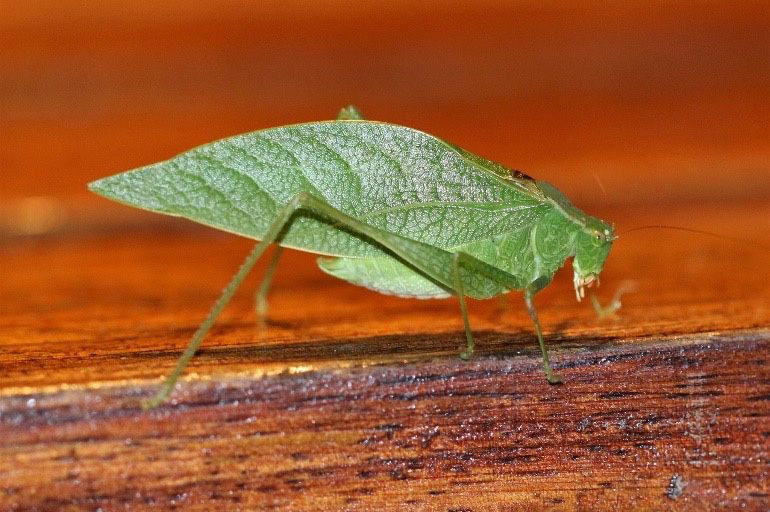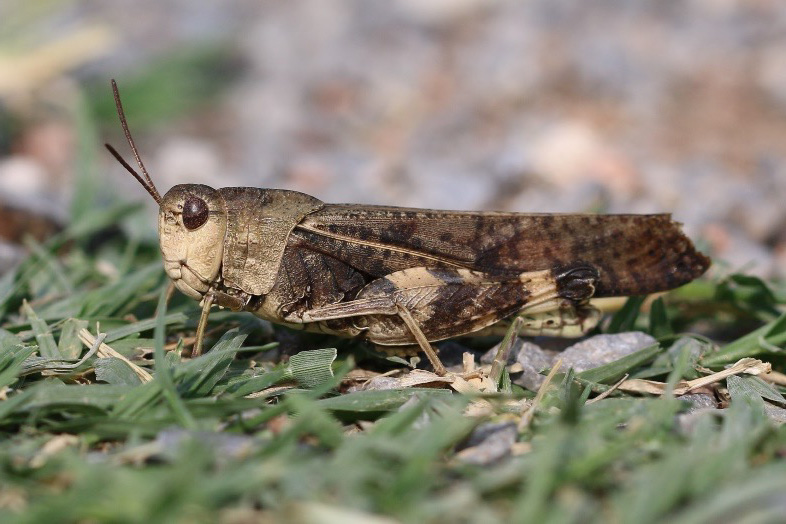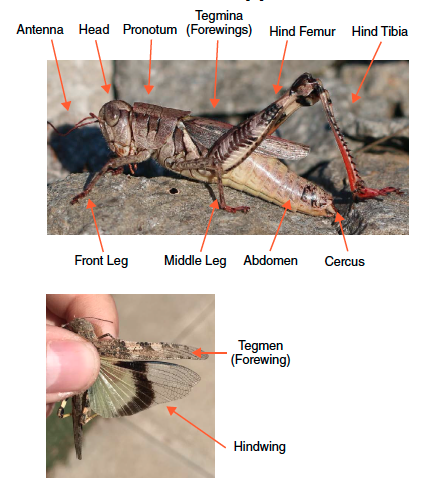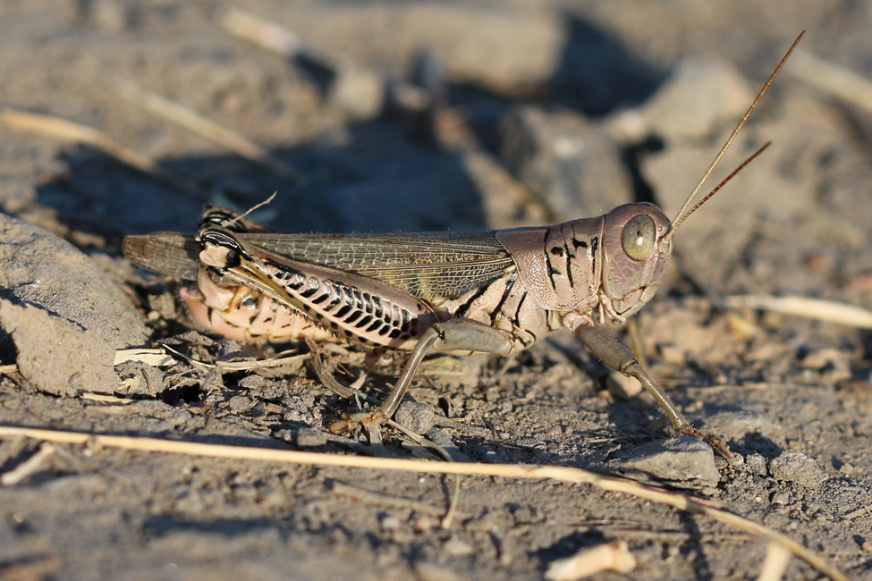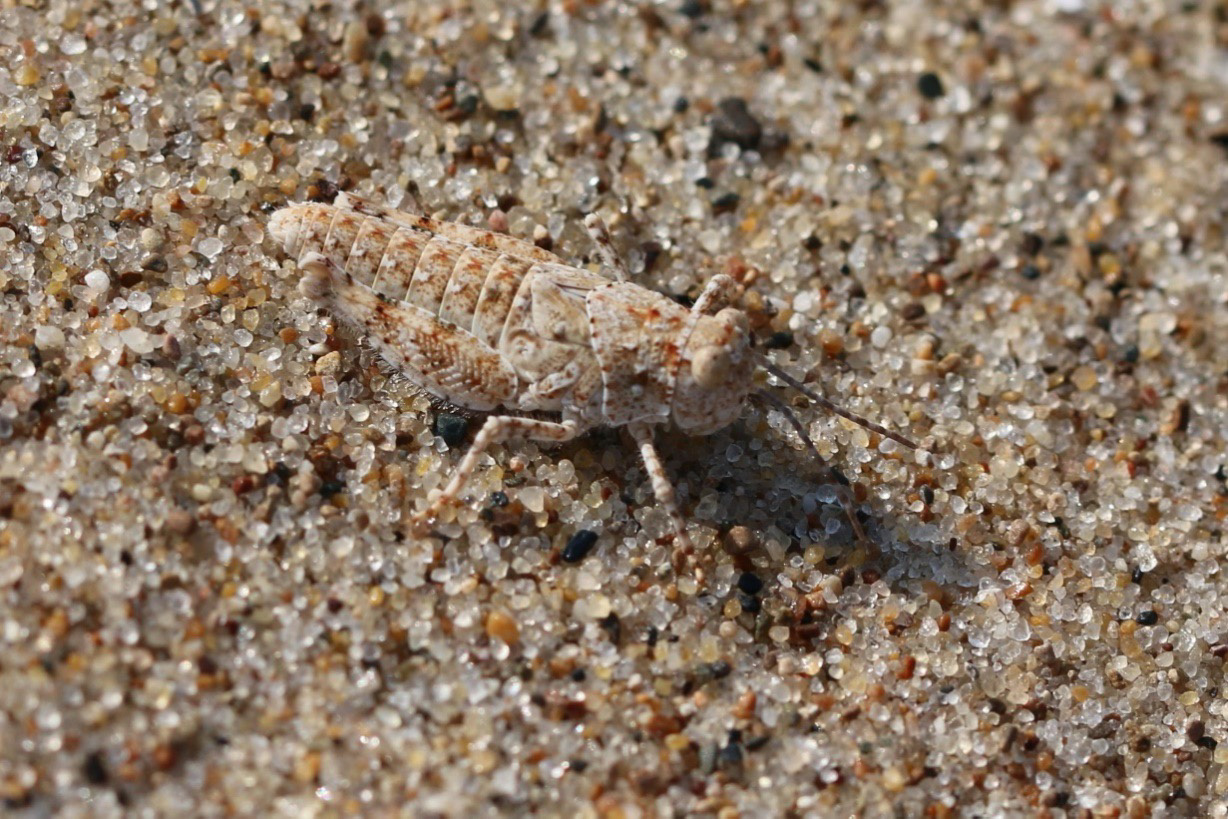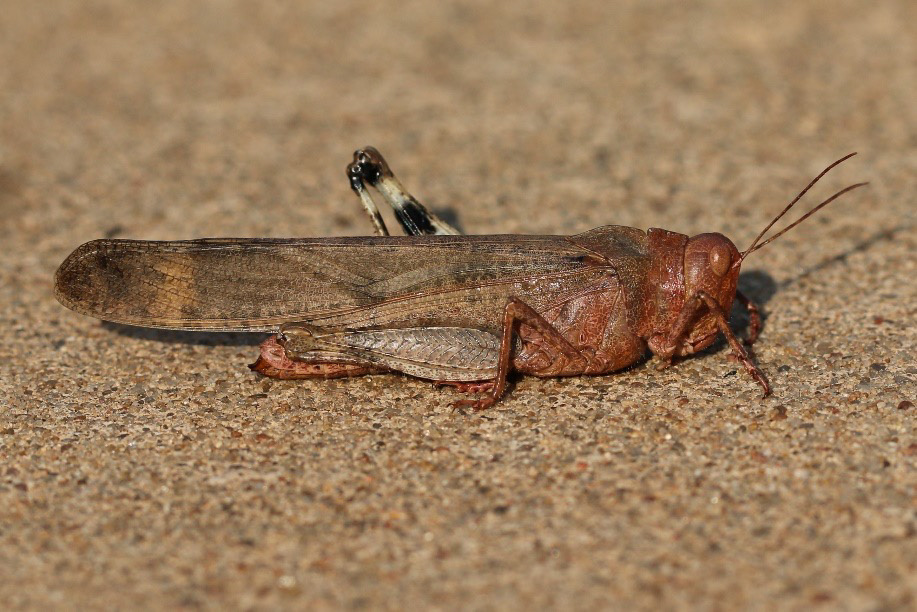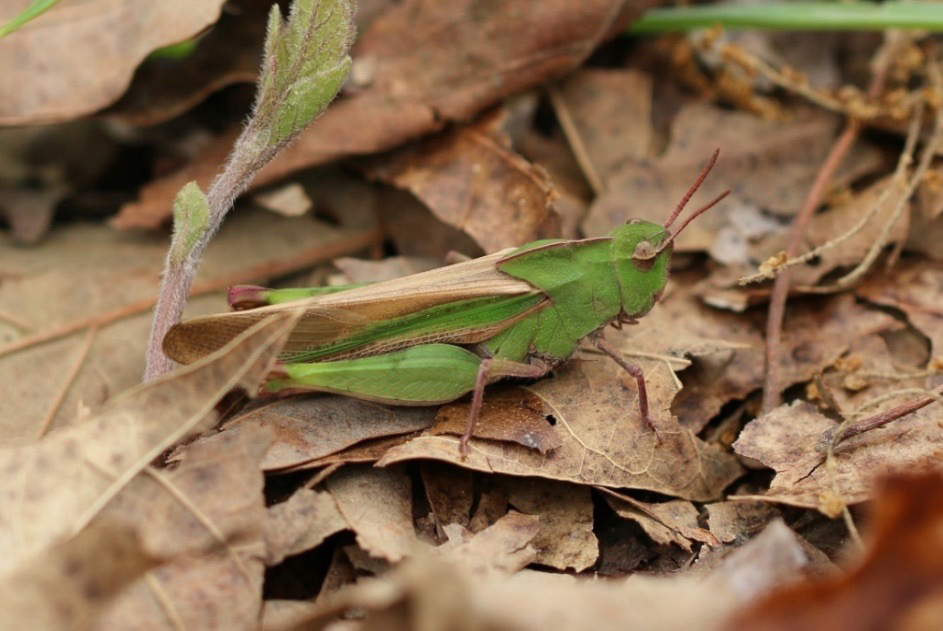Grasshoppers of the Cherokee Nation in Northeast Oklahoma
Grasshoppers and Relatives
Orthoptera is the order of insects that includes grasshoppers, katydids, and crickets. These insects are recognizable by their shape and the presence of jumping hind legs. The physical differences among grasshoppers, crickets, and katydids place them into different taxonomic families. The Cherokee recognize these differences and call “grasshoppers” – KᎳᏧᏆ, DuLaTsuQua, “crickets” – ᏔᎳᏚ, TaLaDu, and “katydids”– ᏏᎩᎩ, SiGiGi.
Grasshoppers and the Cherokee
Because of their abundance, large size, and importance to agriculture, grasshoppers regularly make their way into folklore, legends, and cultural traditions all around the world. In Cherokee culture, one legend featuring a grasshopper is that of The Bird with Big Feet.
In this story, a bird, likely a meadowlark, is teased and bullied by the other animals
for having big feet. Because it feels ashamed, the meadowlark goes into hiding, living
out of sight amongst the tall grasses. However, one day a grasshopper finds the bird,
and asks why it is hiding. The bird replies that it is ashamed of its big feet. The
grasshopper replies that the bird’s big feet are nothing to be embarrassed about,
and that they will probably be useful someday.
When in a nearby wheat field was ready to be harvested, the grasshopper’s words quickly
came true. A mother bird had laid her eggs in the field, and her nest would be destroyed
during harvest. The grasshopper heard her cries and left to get the big-footed bird.
The meadowlark returned and was able to use his big feet to carry the eggs to safety.
The mother bird told all the other animals what the meadowlark had done and from then
on, nobody teased the meadowlark about his feet.
Figure 1.1 and 1.2. A katydid (top) with thin, hair-like antennae versus a grasshopper (bottom) with short, thick antennae.
What is a Grasshopper?
The term “grasshopper” refers only to insects in the suborder Caelifera, sometimes referred to as the “short horned grasshoppers”. These grasshoppers range from tiny, ground-dwelling pygmy mole crickets (not related to true mole crickets) to the large lubber grasshoppers found in western Oklahoma. All the species discussed in this publication, belong to the family Acrididae, the true grasshoppers.
True grasshoppers as a group are easy to identify. They are elongated insects with short antennae and hind legs lengthened for jumping. Katydids and crickets, both of which are close relatives of grasshoppers, are often mistaken for them. Both groups possess similar hind legs, but katydids and crickets tend to have thin antennae that are longer than their bodies, while grasshoppers have short, thick antennae.
Grasshoppers have three developmental stages. They start out as eggs, usually deposited in egg pods within loose soil. The small, immature grasshoppers that hatch from these eggs are referred to as nymphs. They look similar to the adults but have very small wing buds. As they grow, they shed their exoskeleton, growing in size until they reach adulthood. At this point, most species have long, functional wings allowing them to fly. This publication focuses on grasshopper adults, as this is when they are largest and easiest to identify.
Introduction to Oklahoma Grasshoppers
There are over 120 species of grasshopper recorded from Oklahoma. The high diversity of grasshoppers in the state is due to the wide variety of ecoregions that Oklahoma encompasses. Many eastern species reach the western limit of their range in Oklahoma, while many western species reach their eastern limits Oklahoma, and the same can be said for northern and southern species.
While most species of grasshoppers have little impact on human activities, there are a few species that are serious pests. Grasshoppers are considered the most important pests of rangeland in the United States, where they annually consume approximately 22% of available forage. At least two species, the obscure bird grasshopper and the high plains grasshopper, underwent a sudden population increase following drought, leading to crop and grassland damage.
Grasshoppers of the Cherokee Nation
Thirty species of short-horned grasshoppers were recently collected from counties associated with the Oklahoma Cherokee Nation boundaries. This publication highlights the 15 most common and most distinctive species. The grasshoppers covered in this publication can be divided into four subfamilies, based on a variety of characteristics. Becoming familiar with these subfamilies will help the reader narrow down which species is observed and make it easier to identify grasshoppers not covered in this publication.
- Bird Grasshoppers, Cyrtacanthacridinae – large grasshoppers with long wings, powerful flight, and a spur on the underside of the throat.
- Spur-throated Grasshoppers, Melanoplinae – similar to bird grasshoppers but usually shorter and more robust. Also have a spur on the throat.
- Band-winged Grasshoppers, Oedipodinae – usually cryptically patterned with bright hindwings that are flashed during flight. No throat spurs.
- Slant-faced Grasshoppers, Gomphocerinae – thin grasshoppers, usually with a slanted face, that lack throat spurs.
Parts of a Grasshopper
Grasshopper Glossary
Crepitate: The act of making noise in flight, usually clicking or buzzing sounds.
Dorsal: relating to the upper side of the grasshopper.
Savanna: a grassland habitat with scattered trees, sharing characteristics of both forests and prairies.
Sexual Dimorphism: males and females of the same species differ significantly in appearance.
Ventral: relating to the underside of the grasshopper.
American Bird Grasshopper
Schistocerca americana, Cyrtacanthacridinae
Description: The American bird grasshopper is a large, red to orange-brown grasshopper. It has a yellow dorsal line extending down the center of its back and is covered in a variety of dark spots and white lines.
Length: 1.2-2.8 in. (30-70 mm).
Similar species: No other large grasshopper in eastern Oklahoma possesses brown coloration and dark spots on the tegmina.
Habitat: A variety of open habitats including wheat fields, parks, and prairies. Often attracted to lights at night.
Seasonality: Adults begin to appear in late July, with some surviving through the winter until the following May. Peak population occurs August-October.
Discussion: American bird grasshoppers are strong fliers and will regularly fly into the nearest shrub or tree when disturbed. It rarely attains pest status in Oklahoma.
Figure 2. A male American Bird Grasshopper.
Figure 3. A female American Bird Grasshopper.
Obscure Bird Grasshopper
Schistocerca obscura, Cyrtacanthacridinae
Description: The obscure bird grasshopper is a large, green grasshopper with brown wings, a bright, yellow-green stripe down its back, and bright yellow antennae.
Length: 1.4-2.6 in. (35-65 mm).
Similar species: The spotted bird grasshopper, S. lineata, is very similar, but usually has a cream dorsal stripe instead of yellow-green, and is highly variable in color, ranging from green to brown to orange.
Habitat: Found in a variety of semi-open habitats including wheat gardens, parks, and roadsides. Usually the most abundant bird grasshopper in urban areas.
Seasonality: Adults begin to appear in late July, remaining active until cold winter temperatures kill them off.
Discussion: The obscure bird grasshopper is a strong flier. While this species is normally not an important pest, a population outbreak of obscure bird grasshoppers following the Dust Bowl of the 1930s resulted in significant damage to crops and ornamental plants.
Figure 4. A female Obscure Bird Grasshopper.
Mischievous Bird Grasshopper
Schistocerca damnifica, Cyrtacanthacridinae
Description: The mischievous bird grasshopper is a medium-sized, brown grasshopper with a light brown dorsal stripe. This is the smallest species of bird grasshopper in Oklahoma, with the females being short-winged and nearly flightless.
Length: 1.0-2.0 in. (25-50 mm).
Similar species: A light brown spotted bird grasshopper, S. lineata could appear similar, but are longer winged and usually found in grasslands.
Habitat: Found in open wooded habitats, such as forested floodplains and along roads that cut through woodland. It is usually found on the ground where it is well camouflaged amongst the leaf litter.
Seasonality: This species overwinters, with new adults appearing in August and living until the following spring. Peak activity is usually September-October and April-May.
Discussion: Mischievous bird grasshoppers are secretive and rely more on their camouflage to avoid predators than their poor flight capabilities. However, they are one of the most noticeable grasshoppers in woodlands when very few species are active in early spring.
Figure 5. A male Mischievous Bird Grasshopper.
Figure 6. A female Mischievous Bird Grasshopper.
Differential Grasshopper
Melanoplus differentialis, Melanoplinae
Description: The differential grasshopper is a large spur-throated grasshopper that varies in color from dark green to light orange. The large size and the herringbone pattern (chevrons) on the hind femur are distinctive.
Length: 1.2-2.0 in. (30-50 mm).
Similar species: Ponderous spur-throated grasshoppers, M. ponderosus, are similar, but are generally found in woodland habitats and have light bands interrupting the herringbone pattern on the hind femur.
Habitat: Found in a variety of open habitats, especially grasslands, gardens, crop fields, and other disturbed areas.
Seasonality: New adults begin appearing in late July and live until winter.
Discussion: Differential grasshoppers are notable pests of crops throughout their range. They are the most common species found damaging gardens and ornamental plants.
Figure 7.1 and 7.2. Two color forms of the Differential Grasshopper.
Ponderous Spur-Throat Grasshopper
Melanoplus ponderosus, Melanoplinae
Description: The ponderous spur-throat grasshopper is a large, primarily brown spur-throated grasshopper. This species has a herringbone pattern (chevrons) on the hind femur that is interrupted by light bands. Hind tibia color can vary from yellow to red.
Length: 1.0-1.8 in. (25-45 mm).
Similar species: Differential grasshoppers, M. differentialis, are similar but are usually brighter colored and have an uninterrupted herringbone pattern.
Habitat: Found in wooded environments, especially at forest edges. Occasionally found in grasslands, but even then usually found around scattered trees.
Seasonality: New adults begin appearing in late July and live until winter.
Discussion: Ponderous spur-throat grasshoppers appear to hybridize with differential grasshoppers in prairie regions. These intermediates combine the broken herringbone pattern of ponderous spur-throat grasshoppers with the bright yellow color of differential grasshoppers.
Figure 8. A female Ponderous Spur-Throat Grasshopper.
Two-Striped Grasshopper
Melanoplus bivittatus, Melanoplinae
Description: The two-striped grasshopper is a spur-throated grasshopper that is usually dark brown above, cream-colored on the side, with two light stripes going down the back.
Length: 1.0-1.8 in. (25-45 mm).
Similar species: The rare Paratylotropidia brunneri looks very similar but has shorter wings and red hind tibiae (the hind tibiae are gray to blue in two-striped grasshoppers in Oklahoma).
Habitat: Found in a variety of open habitats, especially grasslands, gardens, and crop fields. Often found near water.
Seasonality: New adults begin appearing in late June and live until winter.
Discussion: The two-striped grasshopper is a common pest species of gardens, crop fields, and disturbed areas. It is common in urban habitats.
Figure 9. A female Two-Striped Grasshopper.
Grizzled Grasshopper
Melanoplus punctulatus, Melanoplinae
Description: Grizzled grasshoppers are gray-green, medium sized grasshoppers covered in dark speckles. The inside of the hind femur is red.
Length: 0.8-1.8 in. (20-45 mm).
Similar species: No other species in eastern Oklahoma has such evenly speckled patterning.
Habitat: Associated with a variety of tree species including ash, cottonwood, and pine. Most abundant in savanna settings with scattered trees.
Seasonality: New adults begin appearing in August and live until winter.
Discussion: Grizzled grasshoppers were historically considered nocturnal because they were rarely collected. However, the high number submitted on citizen science websites suggests that they are active during the day, but the fact that they live on trees rather than in the open grassy habitats frequented by most grasshoppers makes them difficult to find. The females lay their eggs in tree bark, which is unusual grasshopper behavior.
Figure 10. A female Grizzled Grasshopper on a tree trunk.
Sulphur-Winged Grasshopper
Arphia sulphurea, Oedipodinae
Description: The sulphur-winged grasshopper is a medium-sized, brown grasshopper with bright yellow and black hindwings. It often has a light-colored stripe extending down its back.
Length: 1.0-1.6 in. (25-40 mm).
Similar species: The autumn yellow-winged grasshopper, A. xanthoptera, is similar but has a raised crest on its pronotum and is active in fall. The plains yellow-winged grasshopper, A. simplex, is longer and has a thinner black band on the hindwing.
Habitat: Open woodlands, forest edges, and grassy fields. Often on bare ground such as road edges but will fly into brush when disturbed.
Seasonality: Active in spring, adults are most abundant in April-May, but some individuals live until August.
Discussion: Like many band-winged grasshoppers, the males make crackling noises, called crepitating, while in flight to attract females.

Figure 11.1 and 11.2. A male Sulphur-Winged Grasshopper (top) and a specimen showing the hind wing pattern (bottom).
Wrinkled Grasshopper
Hippiscus ocelote, Oedipodinae
Description: Wrinkled grasshoppers are large, thick-bodied band-wing grasshoppers. The hindwing color is usually yellow or pink but intermediates occasionally occur. The inner hind femur is banded black and yellow.
Length: 1.2-2.2 in. (30-55 mm).
Similar species: Many similar species of Xanthippus and Pardalophora occur throughout Oklahoma, but they are all early-season species that rarely last until July. In addition, the hind femur color and pattern are distinct.
Habitat: Found in a wide variety of open habitats. Common on lawns, mowed roadsides, and bare clay.
Seasonality: New adults begin appearing in late July and live until winter.
Discussion: Wrinkled grasshoppers are one of the most easily seen grasshopper species in late summer throughout Oklahoma. Despite their abundance, they feed primarily on grass and rarely reach pest status.
Figure 12. A female Winkled Grasshopper.

Figure 13. Two hindwing color variants.
Seaside Grasshopper
Trimerotropis maritima, Oedipodinae
Description: The seaside grasshopper is a medium sized, tan grasshopper. They are usually speckled to match the sandy habitats where they occur. In Oklahoma, the hind tibiae are red. The hind wings are yellow with a black band.
Length: 1.2-1.6 in. (30-40 mm).
Similar species: Other Trimerotropis species in eastern Oklahoma are similar but have bold bands on the forewings and most have yellow tibia. The ridgeback grasshopper, Spharagemon cristatum, has similar colors but has a high crest on the pronotum.
Habitat: Seaside grasshoppers are most commonly found along rivers, especially sandbars and beaches. However, they can be found wherever large areas of open sand are present and can even occasionally be found on gravel roads.
Seasonality: Adult seaside grasshoppers can be found as early as May and as late as October but are most abundant July-August.
Discussion: Maritime grasshoppers are alert, strong fliers making them difficult to approach. However, they almost always land on open sand, where they can easily see predators approaching and blend in extremely well. The coloration of different populations varies to match the sand they are found on.
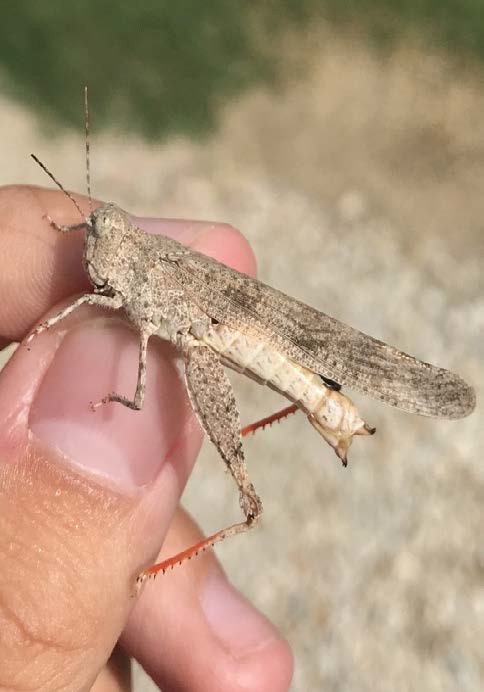
Figure 14.1 and 14.2. An adult (top) and nymph (left) Maritime Grasshopper.
Carolina Grasshopper
Dissosteira carolina, Oedipodinae
Description: Carolina grasshoppers are long, slender, cryptically colored grasshoppers that range from tan to gray. The hindwings are distinct, almost entirely black with a pale-yellow edge.
Length: 1.2-2.4 in. (30-60 mm).
Similar species: While resting, Carolina grasshoppers appear similar to many other band-winged grasshoppers. When its wings are spread during flight, the solid black hindwings edged in pale yellow are distinctive. This coloration is strikingly like that of the mourning cloak butterfly, Nymphalis antiopa.
Habitat: Found open flat area, usually associated with humans, such as parking lots and sidewalks.
Seasonality: New adults begin appearing in late June and live through October.
Discussion: One of the most widespread band-winged grasshoppers in the United States, this species has been able to expand its range to utilize human-made habitats.
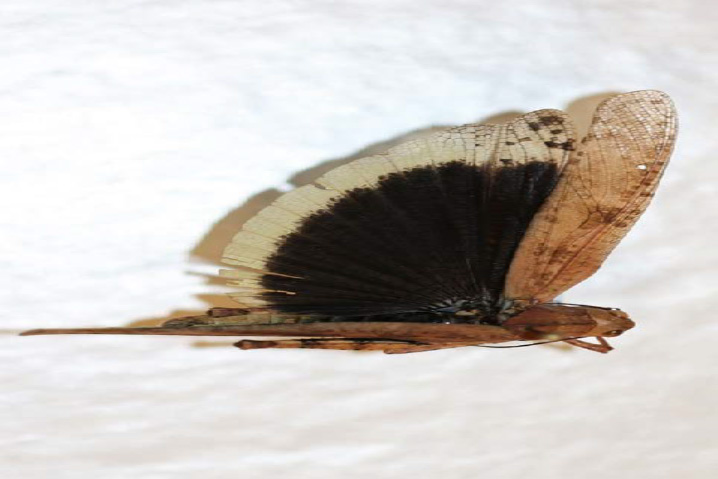
Figure 15.1 and 15.2. A female Carolina Grasshopper (top) and a specimen showing the hind wing pattern (bottom).
Green-Striped Grasshopper
Chortophaga viridifasciata Oedipodinae
Description: Green-striped grasshoppers are medium-small band-winged grasshoppers with translucent yellow and black bands on the hindwings. The body color is usually either brown or green, but occasionally pink variants occur. The pale stripe dividing the eyes in half helps separate it from similar species.
Length: 0.8-1.6 in. (20-40 mm).
Similar species: The various species of Arphia look similar when resting but have much bolder colors on the hindwing.
Habitat: Any open habitat, from lawns and sidewalks to forest edges and rocky outcroppings.
Seasonality: Adults are observed year-round in Oklahoma, with population peaks in April-May and August-October.
Discussion: This species is the most abundant grasshopper in eastern Oklahoma and can be found in all habitats but the densest forests. It feeds primarily on grasses, so it is not considered a major pest despite its abundance.

Figure 16.1, 16.2 and 16.3. Green and brown variations of the Green-Striped Grasshopper (top) and a specimen showing the translucent hind wing pattern (bottom).
Admirable Grasshopper
Syrbula admirabilis, Gomphocerinae
Description: This long-legged, slender slant-faced grasshopper is sexually dimorphic –males and females of the same species vary greatly in appearance. Male admirable grasshoppers are small and brown with dark and light patterning. The larger females are green, with similar dark and light patterning. Both sexes have dark spots on the wings.
Length: Males: 0.8-1.2 in. (20-30 mm), females: 1.4-2.0 in. (35-50 mm).
Similar species: The two species of Mermiria found in the region look similar but lack dark spots on the wings.
Habitat: Open grassy areas, commonly found in lawns and roadsides.
Seasonality: New adults appear in July and live until winter.
Discussion: Admirable grasshoppers, like many species of slant-faced grasshoppers, will often dive toward the ground when disturbed, where they avoid detection by hiding among grass stems.
Figure 17. A female Admirable Grasshopper.
Figure 18. A male Admirable Grasshopper.
Spotted-Winged Grasshopper
Orphulella pelidna, Gomphocerinae
Description: A small, unremarkable grasshopper commonly found throughout eastern Oklahoma. It varies from brown to green, with brown being most abundant in Oklahoma. No bold markings aside from the two dark stripes along the sides of the pronotum, note the row of dark forewing spots.
Length: 0.8-1.2 in. (20-30 mm).
Similar species: The slant-faced pasture grasshopper, Orphuella speciosa, is similar. On average, it is slightly smaller (15-25 mm), has shorter wings extending just beyond the end of the abdomen, and is found in drier, more open environments.
Habitat: Found in a wide variety of habitats, but most often encountered in open woodland and forest edges.
Seasonality: New adults appear in July and live until winter.
Discussion: One of the most widespread grasshoppers in Oklahoma.
Figure 19. A brown variant of the Spotted-Winged Grasshopper.
Two-Striped Mermiria
Mermiria bivittata, Gomphocerinae
Description: This long-legged slender slant-faced grasshopper is one of the longest slant-faced grasshoppers in Oklahoma. It is most commonly pale brown, but occasionally greener, and is marked with a bold dark line extending laterally along each side of the thorax from the eye to the wing. Males in some parts of Oklahoma lack the white stripe on the forewing.
Length: 1.2-2.2 in. (30-55 mm).
Similar species: Most similar to the lively mermiria, Mermiria picta. The lively mermiria is usually green with reddish-brown markings and lacks the light stripes on the sides of the wings of the two-striped mermiria.
Habitat: Open grassy habitats, usually associated with tall grass.
Seasonality: New adults appear in July and live until winter.
Discussion: The two-striped mermiria is another species that will dive into grass bunches to escape predators.
Figure 20. A female Two-Striped Mermiria.
List of Cherokee Grasshoppers
Not all of the grasshoppers found in the Cherokee Nation
could be included in this guide. Many of the ones not included are discussed in the ‘similar species’ portion of the species accounts. Since some of these species lack common names, they are all listed by scientific name, which can easily be search in order to obtain additional information. All species listed here were collected during 2019-2020.
Cyrtacanthacridinae
Schistocerca americana
Schistocerca obscura
Schistocerca lineata
Schistocerca damnifica
Melanoplinae
Melanoplus differentialis
Melanoplus bivittatus
Melanoplus ponderosus
Melanoplus punctulatus
Melanoplus bispinosus
Melanoplus sanguinipes
Melanoplus keeleri
Melanoplus femurrubrum
Campylacantha olivacea
Phoetaliotes nebrascensis
Oedipodinae
Hippiscus ocelote
Hadrotettix trifasciatus
Trachyrhachys kiowa
Dissosteira carolina
Spharagemon bolli
Trimerotropis maritima
Arphia sulphurea
Arphia xanthoptera
Chortophaga viridifasciata
Gomphocerinae
Syrbula admirabilis
Metaleptea brevicornis
Amblytropidia mysteca
Orphulella pelidna
Orphulella speciosa
Dichromorpha viridis
Mermiria bivittata
Alex J. Harman
Department of Entomology and Plant Pathology
W. Wyatt Hoback
Department of Entomology and Plant Pathology
Tom A. Royer
Department of Entomology and Plant Pathology

